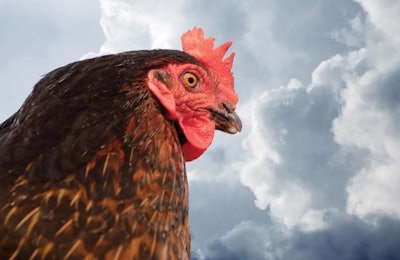
Russia’s broiler producers can expect a difficult year ahead. The country is now largely self-sufficient in chicken meat, consumption levels on the domestic market are expected to remain flat, and the export market is hampered by the strengthening ruble and outbreaks of avian influenza. Alongside these difficulties, changes to government support schemes are causing uncertainty, particularly for smaller companies.
Slowing poultry meat output
Russia’s poultry producers are now, in some ways, having to face up to their own success, as 20 years of strong growth comes to an end.
After increasing by 2.4 percent last year, Russian broiler production is forecast to grow by only 0.8 percent this year, reaching 3.75 million metric tons (MMT), reports the U.S. Department of Agriculture's Foreign Agricultural Service. While still positive, the figures are in marked contrast to the growth rate achieved over the previous two decades, which averaged 14 percent per year.
Russia has become largely self-sufficient in poultry meat, and imports are falling. While exports may present a new opportunity for Russia’s producers, selling overseas is not without its difficulties. The strengthening ruble, along with disease outbreaks, have seen Russia lose some of the export markets it has already won, leading to a glut of chicken meat on the home market, and downward pressure on prices.
Imports are expected to continue falling and exports to rise, particularly as the government is now offering help to companies wanting to sell beyond Russian borders, yet the sector still needs to undergo further change.

The high growth rates enjoyed by the Russian poultry industry have come to an end as the country has reached self-sufficiency for poultry products.
Home market key focus
While exports will become increasingly attractive for Russia’s chicken producers, in the immediate term their key focus remains on the domestic market, and the industry will need to focus on efficiency, not volumes, to flourish.
Despite the 2.4 percent rise in production last year, several of the country’s major broiler-producing regions reported falling output, and smaller companies have found it increasingly difficult to compete.
Producers have been hit not only by restrictions on exports causing oversupply at home but, from early 2015, consumer prices failed to keep pace with the rate of inflation. This, combined with higher compound feed prices in the first half of last year, resulted in a particularly hard squeeze on margins.
The decrease in profitability and weak demand not only led to producers scaling back production plans last year and for the first quarter of this year, but in some cases shutting down capacity, particularly after mergers or changes in ownership.
While it remains to increase volume sales at home, 2017 has seen margins improve for Russian producers. Feed prices are now more favorable, after a record grain harvest, while the wholesale price for whole chicken rose by 32.1 percent between January 2016 and January 2017, offering some solace for the year ahead.
Another bright spot for producers is that, after two years of recession, the closing months of 2016 suggested that an improvement in the Russian economy is starting to take place. The contraction in the retail trade is slowing and inflation is moderating. While real incomes have been falling, the number of poor in the country is no longer increasing, and the Russian economy is expected to expand by 1.5 percent this year.
Despite this turnaround, production remains constrained by price-sensitive consumer demand, competition from other meats, and limited access to funding.
While the Russian economy may be returning to health, a new uncertainty has emerged for Russian producers. Russia has focused on import substitution and self-sufficiency and, where poultry meat production is concerned, this has been largely successful.
However, the government has redesigned its agricultural support program for 2017, moving away from production growth and instead focusing on operational efficiency. For those companies able to access funding and investment, produce more efficiently, and benefit from economies of scale, the outlook may be bright. For smaller companies, however, the outlook is not so clear.
Moving to a new distribution system for subsidies has increased uncertainty, and many broiler producers, particularly those of a small or medium scale, are excluded from preferential credits for operational needs and development. Those companies located in regions where broiler production is not classed as a priority industry will be hardest hit by the change, suggesting a further consolidation of the industry is about to take place.
Imports and exports
The counter-sanctions on food imports imposed against several countries are expected to continue until at least the end of this year.
Forecasts suggest imports will fall by 15,000 metric tons in 2017 to 200,000 metric tons, and that this downward trend will continue beyond the year-end. The rate of decline, however, will be influenced by the strength of the ruble. If the ruble continues to rise, local producers will have to continue to look to efficiencies or risk losing out to cheaper imports.
The rising ruble is already thought to be hampering exports, forecast to reach 115,000 metric tons this year, lower than some had predicted when the currency was weaker.
However, the ruble had not been the only difficulty confronting Russia’s broiler meat exporters. Outbreaks of highly pathogenic avian influenza have also seen Russian broiler meat shut out of several markets.
Even in the absence of disease, export markets have not proved easy for Russian producers and there are reports that producers have not always been able to adjust their product offering adequately to align with the demands of foreign markets. Yet, demonstrating how the industry has matured and how government priorities for agricultural production is changing, the Russian government is supporting trade missions to help the poultry industry penetrate overseas markets. Strategic markets are thought to be the countries of the former Soviet Union, the Middle East and Asia.

Russian poultry producers are increasingly looking overseas to make up for sluggish demand at home.
Learn more about Russian producers:
www.WATTAgNet.com/directories/80.html


















